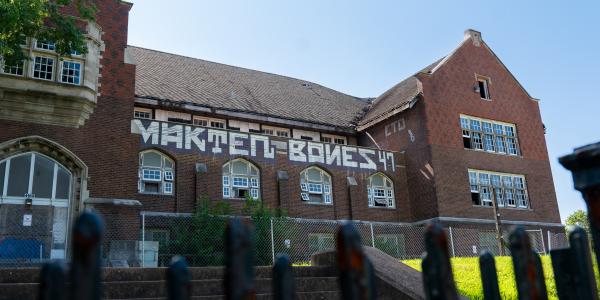Through an exhibition and her work as a PhD candidate, Clark highlights the innovative, student-centered spirit of Scullin School that shaped her journey as an educator.

Hometown: St. Louis
Olin Library Exhibit: “An Exceptional Legacy: The Scullin School Artifact Collection” (1985–2003)
Career mission: To form a collaborative educational task force to help pioneer the next generation of high-quality, future-ready schools in the United States
Awards and honors: McDonnell Symposium 3MT Competition global finalist (2023); McDonnell International Scholars Academy fellowship recipient (2023); John B. Ervin Award recipient (2023)
When VaNetta Clark thinks back to her elementary school experiences at Scullin School in North St. Louis, what she remembers most is the building’s atmosphere. There was an electricity in the air, a pervasive sense of excitement that brought out the eager learner in her.
“When you walked into that environment, it literally felt like you were receiving a big hug,” Clark said.
But for Clark, now a PhD candidate in the Department of Education, her time at Scullin in the 1990s isn’t just a fond memory. It’s an experience that changed the trajectory of her life, with lessons that continue to reverberate through her career. Clark taught for 10 years at Aspire Academy, adopting a classroom approach inspired by Scullin’s creative, problem-solving approach to learning. In 2018, she won her school district’s educator of the year award, as well as a Golden Apple Award from the St. Louis American’s Newspaper in Education program.
This fall, Clark will pay tribute to Scullin with an exhibition at Olin Library, featuring photographs, awards, student work samples, and other artifacts from the school, which closed in 2003. On display until February 2026, the exhibition will chronicle the history of an institution whose forward-thinking, student-centered approach brought national media attention and acclaim to St. Louis while changing countless lives.
Clark spoke with the Ampersand about the exhibit and Scullin’s ongoing influence on her life.
Was there a particular educator at Scullin who had an impact on you?
Yes, absolutely. My fourth-grade teacher, Mrs. Magnolia Bush-Tabb. I came into her classroom with a less-than-ideal history of fighting and being identified as a student at risk for gang activity. But she didn't shy away from that.
She saw my talent as a leader, created the Student Concern Committee (SCC), and made me president. Through the SCC, we developed creative strategies for conflict resolution at the school. This was paramount to my development as a student.

When Scullin received recognition from the White House and U.S. Department of Education for its drug prevention program, Mrs. Tabb selected me to attend the ceremony in Washington, D.C., which was life-changing. She showed me life outside of my environment and how I could dream beyond the space where we lived.
Tell us about the research process for your exhibition.
The idea was to highlight my experience with Mrs. Tabb. But when I called her, she encouraged me to consider honoring the full school. It turned into what we call “snowballing” in research: You reach out to one person, and then someone else reaches out, and it continues to grow. The stories that participating teachers shared through independent interviews and focus groups were phenomenal.
What I didn’t anticipate was that some of the teachers who participated in the study had maintained 30 years of artifacts — evaluations, state assessments, student projects, and awards from various organizations such as Monsanto and the Danforth Foundation.
Given that Scullin has been shuttered since 2003 and the building stands in disrepair, do you see this exhibition as a way to reclaim some of its history?
Yes, when you Google the school, you see the devastation. But this exhibition allows me to highlight the practices of the teachers and the academic growth of the students, as well as the initiatives and partnerships that helped shape Scullin's rich history. I am highlighting the richness that once filled the building – and that still lives in our memories.

What motivated you to pursue your doctorate at WashU after your teaching career? How has the program helped you to realize your goals?
It was a very difficult decision to step away from the classroom. I had been at the same school for almost 10 years, so I was very connected to the students and their families. My decision to leave the classroom wasn't because I didn't believe in the power of education; I wanted to make a broader impact within the educational field.
I started at WashU through University College, where I met Rowhea Elmesky, an associate professor in the Department of Education. I shared my classroom, personal, and educational achievements with her, and she suggested that I apply for the PhD program. She understood my desire to influence education not only in St. Louis, but nationally and globally. When we think about education in the U.S., we want students to be able to compete on an international level.
Unfortunately, the current statistics on American schools show a downward trend. For me, that’s alarming. But it's also the perfect opportunity to implement dynamic ideas and rethink the educational experience.
Being at WashU is like being a plant in exceptional soil. The university has helped me grow my ideas for advancing the field of education and use research to achieve those goals.
Clark’s exhibition, “An Exceptional Legacy: The Scullin School Artifact Collection”, will be on display in the Ginkgo Reading Room at John M. Olin Library from October 11, 2025, to February 1, 2026.





